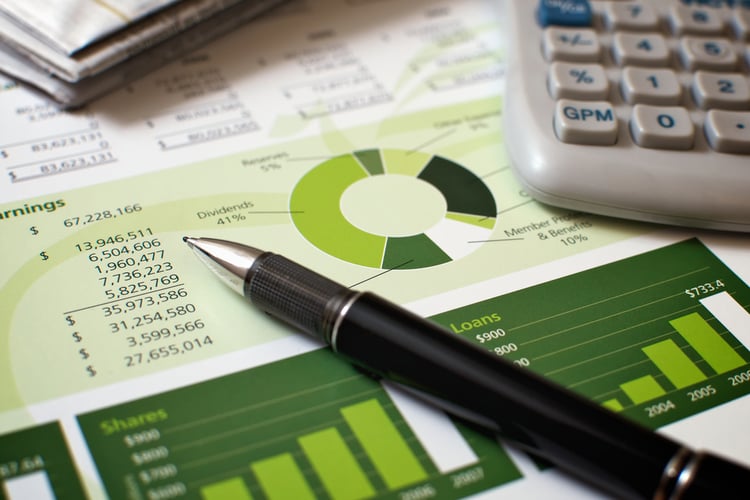Solar Power Finance: Understanding Basic Concepts

Solar power has become the fastest growing electricity source in the US, and this represents billions of dollars invested each year. Photovoltaic technology has been used successfully around the world, but a feasibility study is recommended before any installation. This involves not only the technical aspects of installing solar panels, but also their financial performance over time. In this article, we will review some basic concepts of financial analysis that are used to decide if a solar power project makes sense.
Get a professional feasibility study and design for your commercial solar power system.
Energy efficiency and renewable generation projects are often presented with a simple payback period: How long must the owner wait before recovering the upfront cost? For example, if a commercial solar array that saves $100,000/year has a cost of $600,000, the simple payback period is six years. However, this approach can be misleading because most projects are not paid in a single upfront sum.
Many companies and building owners prefer to avoid upfront costs by taking a loan, which is paid over time with the savings achieved. Ideally, you should look for a loan that will result in annual payments lower than your energy savings. The out-of-pocket cost becomes zero, the payback period is instant, and the project essentially pays itself.
The Best Financial Performance Metrics for Solar Power Projects

The simple payback period is popular due to its simplicity, but it has two limitations when applied in solar power projects:
- The calculation assumes you pay the full project cost upfront, ignoring loan financing and ongoing costs like part replacements.
- The simple payback period also assumes that annual savings remain constant, which is not the case. Energy prices tend to rise over time, and the savings achieved with renewable generation also increase.
To get a better picture of how a solar panel system will perform financially, you can use the metrics described in the table below. Unlike the simple payback period, these financial metrics account for loan financing, maintenance, and external factors like electricity price inflation.
|
Financial Metric |
Description |
|
Net Present Value (NPV) |
The economic value of a project in present-day dollars, considering all savings and costs during its lifetime. |
|
Levelized Cost of Electricity (LCOE) |
The average electricity price at which the solar project breaks even. The LCOE can also be described as the income per kWh or savings per kWh at which the project breaks even. |
|
Benefit Cost Ratio (BCR) |
Economic benefit achieved per dollar invested, expressed in present-day dollars. |
In general, an investment makes sense if the net present value is positive and the benefit/cost ratio is higher than 1. When a project breaks even in present-day dollars, the NPV becomes zero and the BCR is exactly 1. A negative NPV and a BCR below 1 indicate that a project loses money, and the owner should consider other options.
The Levelized Cost of Electricity or LCOE can be a tricky financial metric. It can be described in simple terms as the value of electricity at which the solar power system breaks even, but this has different meanings depending on the goal of your project: are you generating electricity for self-consumption, or are you selling it through the grid? To understand the concept better, consider a solar power project with an LCOE of 10 cents/kWh.
- If the project is used for self-consumption, the LCOE of 10 cents/kWh represents the minimum savings required to break even. This project would make sense if your electricity provider charges 15 cents/kWh, but not if they charge 8 cents/kWh.
- On the other hand, if you sell the electricity of the solar PV system, the LCOE represents the minimum sales prices at which you break even. In this example, the electricity must be sold at no less than 10 cents/kWh.
The savings per kilowatt-hour of solar energy tend to change over time, while the LCOE calculation assumes a constant price during the entire service life of a project. However, the LCOE is a useful metric when comparing different electricity sources, and also when deciding if an onsite generation system is a better option than your electricity provider.
How Solar Incentives Affect Your Financial Analysis

There are many types of incentives for solar power, and they vary by location. All solar PV systems in the US are eligible for a federal tax credit regardless of their size, and business-owned systems also qualify for accelerated depreciation (MACRS). You can write them off in only five years for tax purposes, while their typical service life is over 25 years. Additional incentives may be available depending on your state, city and power company. They may include cash rebates, renewable energy certificates (REC), or local tax benefits beyond the federal ITC and MACRS.
A solar financial analysis is only accurate when it also considers local incentive programs. In general, incentives will increase the NPV and BCR, while shortening the payback period. Incentives that reduce ownership costs will also lower the LCOE, which means the project can break even at lower electricity prices.

Michael Tobias
Michael Tobias, the Founding Principal of NY Engineers, currently leads a team of 150+ MEP/FP engineers and has led over 4,000 projects in the US
Join 15,000+ Fellow Architects and Contractors
Get expert engineering tips straight to your inbox. Subscribe to the NY Engineers Blog below.

